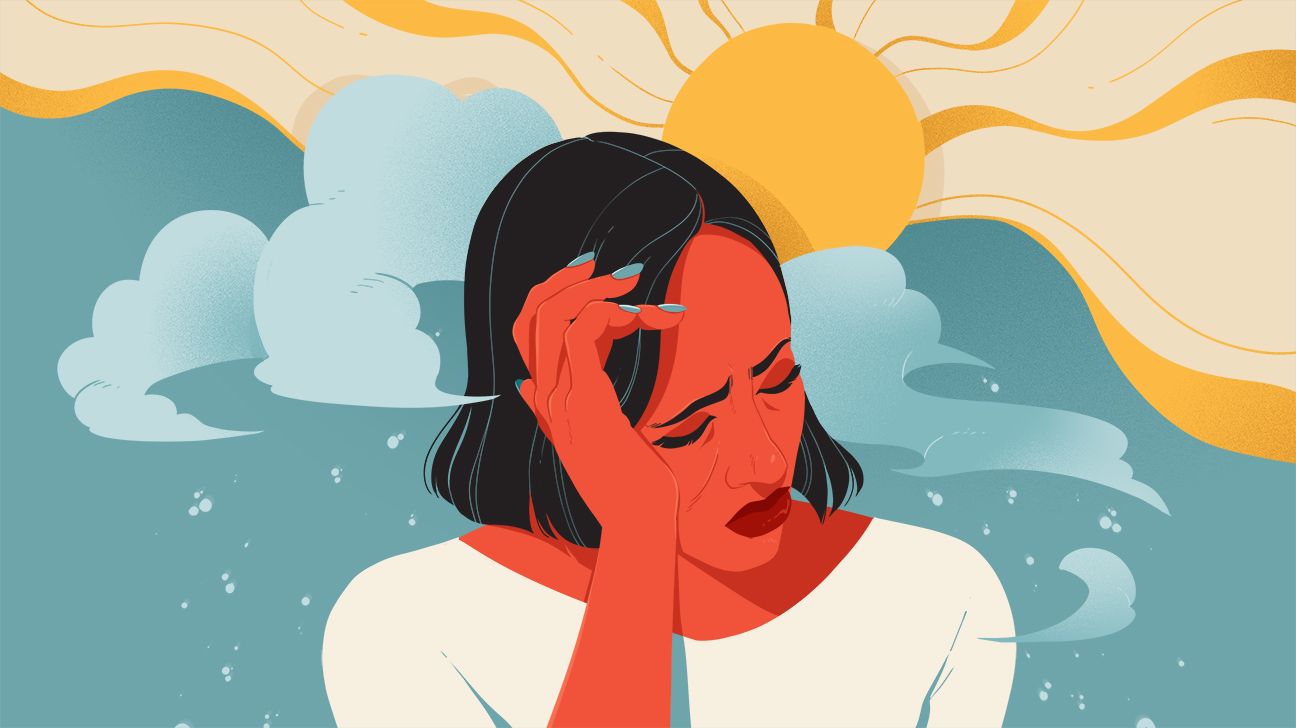An All-Seasons Guide to Managing Weather-Related Migraine Triggers
June 17, 2020
Content created for the Bezzy community and sponsored by our partners. Learn More

Bad weather, migraine attack? For many people living with migraine, changes in weather can be a trigger, particularly if there’s a sudden shift in barometric pressure, humidity, or cold or dry air.
Unfortunately, you can’t change the weather. But there are some things you can do so shifts in the weather are less potent migraine triggers.
“Often, weather itself is rarely the trigger, although it can be in some cases. Instead, there may be other triggers that go along with these weather patterns that can be controlled, and that will help to reduce the risk of a migraine,” says Dr. Medhat Mikhael, a pain management specialist at MemorialCare Orange Coast Medical Center.
Here’s a guide to what the seasons might bring — along with some tips on how to handle weather-related migraine triggers all year long.


Spring
The trees are budding, the grass is growing, the chill is lifting — and you’re lying in bed with a debilitating migraine attack. As pretty as spring might be, it’s also a time when allergens begin floating everywhere.
According to Mikhael, people with allergies are much more likely to develop migraine attacks and have them more frequently than those who don’t. This is due to increased inflammation from the release of histamines to control your allergic reactions.
Spending more time inside when allergy conditions are highest, and taking allergy medications, can be helpful for heading off a migraine attack.
An additional spring issue is rain and the drop in barometric pressure that may come with it. When there’s less barometric pressure (the pressure in the air), it can create an imbalance between the air in your sinuses and the air around you.
Much like when the air pressure changes in an airplane as you take off, you might have discomfort that results in a migraine attack, Mikhael explains.
“In the case of pressure, medications can be helpful,” he says, adding that over-the-counter pain relief meds may be a good preventive measure at the first sign of pressure changes, especially if you’ve had an issue with it before.
Summer
As the humidity increases, migraine attacks can become more of an issue, in large part because of air pressure changes again.
Another issue can be longer days with brighter sunlight, which increases the amount of sun glare.
Since this intensity of light can be a trigger, Mikhael suggests preparing for this by putting sunglasses on before stepping outside. Also, keep extra sunglasses in various locations, like your office, car, or bag.
Summer also brings changes in schedules and more get-togethers for many people, which could mean more alcohol consumption and a wider array of foods.
Both of these can be migraine triggers, Mikhael says, and when you add in the humidity and brighter light, it could all add up to higher risk.
Fall
As cooler, crisp weather begins, the days get shorter and some people experience a change in sleep schedules as a result. Poor sleep and higher likelihood of migraine attacks are strongly associated with one another, Mikhael says.
“Focusing on good sleep habits is a very important part of migraine management,” he notes.
This is also another period of the year when allergies can increase and barometric pressure changes occur, which may both combine to increase migraine occurrence.
Winter
Although winter may bring relief from outdoor allergens, people in colder climates may struggle with a major contributor to migraine attacks: hydration.
Mikhael says dehydration is a very common cause of migraine attacks, and people tend to drink less water in the winter. We also tend to spend more time indoors in the winter, where air tends to be drier.
Putting yourself on a regular hydration schedule — drinking a 6-ounce glass of water each hour from breakfast to after dinner, for example — can be helpful for maintaining hydration during the winter months.
Winter is also notorious for a downshift in physical activity, and becoming more sedentary can have a ripple effect that ends in a migraine attack. For example, minimal exercise has been associated with less-than-healthy food choices and higher amounts of stress.
All of those factors can act as migraine triggers. Consider making exercise a priority, like taking a yoga class a few times a week, or walking outside in the fresh air for at least 15 minutes a day, Mikhael suggests.
Tracking your symptoms can help you avoid weather-related migraine triggers
No matter what the season, Mikhael suggests keeping a journal of daily activities that can help you pinpoint what’s going on when migraine attacks occur. This includes weather, food choices, stress level, sleep quality, and medication usage and timing.
“Staying aware of how your migraines might happen more in one season than another can be crucial for avoiding triggers,” he says. “The more you can understand all of the factors that go into what’s happening, the more you and your doctor can work together on treatment that reduces migraine episodes.”
Article originally appeared on June 17, 2020 on Bezzy’s sister site, Healthline. Last medically reviewed on June 16, 2020.
Medically reviewed on June 17, 2020
3 Sources


Like the story? React, bookmark, or share below:
Have thoughts or suggestions about this article? Email us at article-feedback@bezzy.com.
About the author